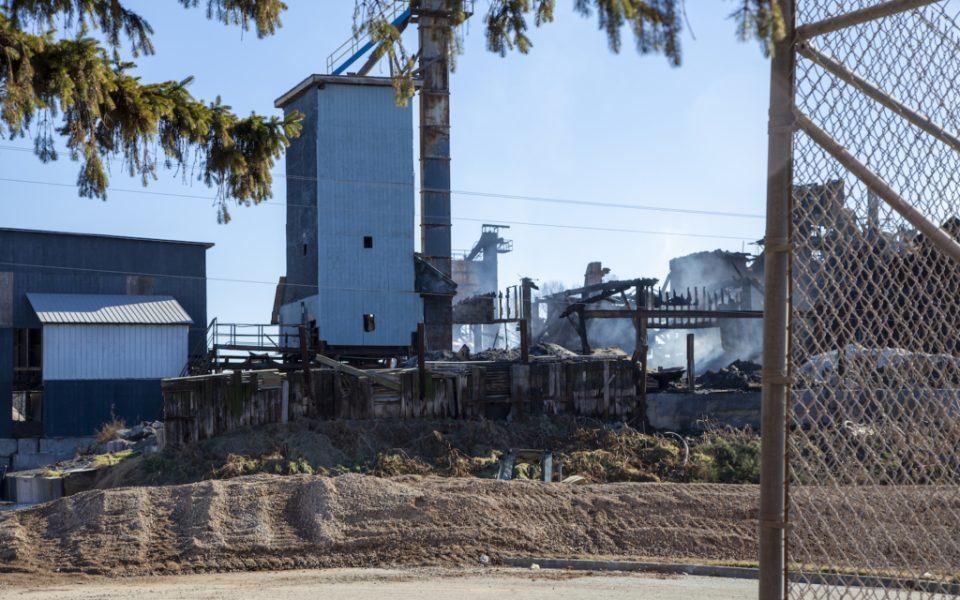This story originally appeared at NC Policy Watch on March 4.
Before a massive blaze erupted at the Weaver Fertilizer plant in late January, it was storing more than 2,000 tons — roughly 4.5 million pounds — of chemicals every day at its facility in Winston-Salem, according to the company’s most recent chemical inventory filed with state emergency management officials.
Weaver Fertilizer didn’t submit a chemical inventory to the state in 2020, in violation of federal reporting law. The deadline for the 2021 report was March 1.
The recent inventory shows that on a typical day in 2021 the plant had an average of 30 tons of ammonium nitrate on hand, with a daily maximum of 60 tons. However, just a month into 2022, when the fire erupted on Jan. 31, Winston-Salem Fire Chief Trey Mayo publicly announced that nearly 600 tons of ammonium nitrate had ignited; that’s 10 to 20 times greater than amounts listed in the report.
Michael Spence, who filed the report on behalf of Weaver Fertilizer, told Policy Watch today that there was a typographical error. The daily maximum was, in fact, 600 tons, or 1.2 million pounds.
Ammonium nitrate, a main component in fertilizer, and burned for four days. The risk of explosion was so great that Winston-Salem officials asked people to evacuate within a mile radius, temporarily displacing 6,000 residents. The Winston-Salem Fire Department has not yet issued an investigation report or announced the cause of the blaze.
Although ammonium nitrate isn’t inherently explosive, it is classified as an oxidizer. It can catch fire, smolder or explode under certain circumstances, such as if it is stored in a confined space or comes into contact with hot materials. American terrorist Timothy McVeigh used ammonium nitrate to blow up the federal building in Oklahoma City in 1995. Roughly 250 tons of the material exploded in West, Texas, in 2015, killing 15 people and flattening entire neighborhoods.
Nonetheless, federal regulations for ammonium nitrate are lax. Weaver Fertilizer was legally allowed to store the material in wooden buildings without sprinkler systems because the structures met code requirements at the time they were constructed, as early as 1939.
The recent inventory lists 26 chemicals that were stored “365 days” a year at Weaver. Diesel fuel oil was in above-ground storage tanks, about 1,600 gallons on average, with a maximum of 8,000 gallons. Individually, many of the chemicals and compounds were listed as eye or skin irritants. However, in combination with other materials, the chemicals could create other health hazards. For instance, when urea catches fire it melts and decomposes, according to the National Library of Medicine, a federal database. Burning urea generates ammonia, a toxic gas.
Weaver stored on average 138 tons per day of urea, with a daily maximum of nearly 250 tons.
Similar to ammonium nitrate, two other oxidizers, potassium nitrate and calcium nitrate were stored at the plant, according to the inventory. Potassium nitrate amounts ranged from 37 tons to 62 tons. (The inventory did not list potassium nitrate as an oxidizer, but the federal database classifies it as one.)
For calcium nitrate, the amounts were 7 tons to 10.5 tons. The federal database also lists calcium nitrate as a corrosive.
There was also a chemical onsite that had fire retardant properties — diammonium phosphate. Potassium chloride was once used as a fire extinguishing agent. It’s used in some de-icers
The chemicals were stored in “open covered” storage bins or in secure areas of the warehouse, according to the inventory.
Join the First Amendment Society, a membership that goes directly to funding TCB‘s newsroom.
We believe that reporting can save the world.
The TCB First Amendment Society recognizes the vital role of a free, unfettered press with a bundling of local experiences designed to build community, and unique engagements with our newsroom that will help you understand, and shape, local journalism’s critical role in uplifting the people in our cities.
All revenue goes directly into the newsroom as reporters’ salaries and freelance commissions.


Leave a Reply